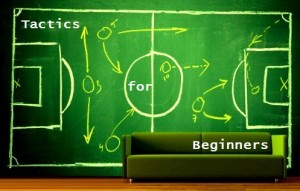By Bob Pearce and Mihail Vladimirov.
You’ve mentioned pressing several times so far. Could you say, in one sentence, what is the purpose of pressing?
Denying your opposition time on the ball.
How is ‘pressing’ different from ‘marking?
Pressing is a form of marking, but not directly man-to-man personal marking per-se. The usual man-marking is to take your opponent out as a potential receiver of the ball. Hence you are limiting him in terms of ‘off the ball’ actions. Pressing could be seen as limiting him in terms of ‘on the ball’ actions. By pressing you are effectively limiting your direct opponents’ choices on the ball by limiting his potential passing and movement angles.
It seems that pressing is a defensive strategy and an attacking strategy at the same time.
Depends on the type of pressing you are using. I wouldn’t call it defensive or attacking, instead I’d divide them into passive and active pressing.
The aim of passive pressing – I’m calling it ‘closing down’ – is to limit the time the opposition has on the ball by simply engaging them. That process of engaging is aimed at just forcing the player on the ball to act faster and have to make rushed judgements, with the intention that he makes the wrong decision or his pass is not accurate. This closing down doesn’t aim to go near the player and tackle him in order to dispossess him. It is just about your players approaching the opposition players and ‘threatening’ them by closing them down.
When would you use ‘closing down’?
Logic dictates that when Blue team plan to play with the majority of their team behind the ball, focussing on limiting the space for Red team, and flooding the key defensive zones by playing deep and narrow, the ‘closing down’ process is more suitable.
By ‘closing down’ the Red team (preferably once they reach the midfield zone, rather than higher up the pitch), Blue team are not giving them an easy ride to settle into a passing flow that would be threatening to them. They have already made Red team’s job harder by squeezing the space. And by closing them down, Blue team are then making Red team’s job even harder by limiting the time they have on the ball. This will lead to Red team starting to get frustrated and eventually beginning to make mistakes which Blue team could capitalise on.
So the passive ‘closing down’ is about delaying decision-making, discouraging forward movement, and encouraging mistakes by ‘rattling their cage’ a bit. They may not win the ball back but will still contain the play well away from the hot zone.
Then the active type is what I call a pure ‘pressing’ process. It’s more aggressive than ‘closing down’, with the aim that your players approach the opposition player in order to tackle them, dispossess them, regain the ball, and head forward on the counter.
And when is pure ‘pressing’ suitable?
The aggressive pressing process is needed when Red team intend to be the dominating team, looking to pin back Blue team both with and without the ball. In possession, Red team’s spreading forward would push Blue team back and threaten to overrun them all over the pitch. Then whenever Blue team have the ball, Red team’s aggressive pressing would be the natural extension of them completely dominating the opposition, with the aim of quickly getting the ball back in their possession.
So we could say, using your terminology, the passive type is ‘defensive’, as it just aims to limit time on the ball and force the opposition into mistakes. The active pressing is ‘attacking’ as the aim is to dispossess the opposition and construct quick counter-attacks.
Possession-focused football sets out to ‘own’ the ball, and mitigates the risk of being exposed by ‘stealing’ possession back again quickly. Aggressive pressing is a bit like ‘mugging’ your opponent to steal their possession.
The ‘mugging’ term is about right. Also, a team might decide to press if they intend to completely ruin the passing flow and to minimise the time on the ball the opposition will have. For example, a team like Stoke might decide to press a team like Liverpool.
So a reactive team defends by smothering the space in their defensive zone, and a proactive team defend by smothering the space wherever the ‘active zone’ is.
Precisely. Or to expand further, the reactive team will defend by flooding their defensive zone by having a deep and narrow defensive line (to compress the space), but might look to ‘close down’ in midfield (to limit the time on the ball the opposition will have). Meanwhile the proactive team will look to press as soon as they lose the ball, no matter where on the pitch.
What could stop pressing being successful?
Two things mainly. The first one is self-inflicted. If the team is not pressing zonally with the required structure and proper timing as a unit, and also not properly supporting the pressing player or players.
The other reason is inflicted by the opposition. If they have suitable organisation in terms of creating the required passing angles to use them as out-balls, they would be able to bypass the pressing often enough. This being said, it’s easy to bypass a pressing wave, either through the middle or down the flanks, if you have a numerical advantage. With this in mind, the more technically and physically capable the team are, the easier they will be able to bypass the opposition’s pressing waves.
Moving forward with short passes in a compact swarm means when you lose possession you are ready to press in a compact swarm. Then pressing in swarms seems to be as much about being able to snatch the ball back quickly after it is lost with the swarm being available and ready to take that regained ball and recommence their passing chain building again.
The rest of this article is for Subscribers only.
[ttt-subscribe-article]
